Sales in Commercial Alleys and Their Association with Air Pollution: Case Study in South Korea
Abstract
1. Introduction
2. Materials and Methods
2.1. Workflow
2.2. Datasets
2.3. Target and Predictor Variables
2.4. Machine Learning Techniques
2.4.1. Models
2.4.2. Partial Dependence Plots (PDPs)
3. Results
3.1. Prediction Performance
3.2. Importance of Predictor Variables
3.3. Joint Association of Air Pollution and Income with Sales
4. Discussion
5. Conclusions
Supplementary Materials
Author Contributions
Funding
Institutional Review Board Statement
Informed Consent Statement
Data Availability Statement
Conflicts of Interest
References
- Liao, S.; Liu, K.; Yang, Y.; Liu, Y. The Correlation between Convenience Stores’ Distribution and Urban Spatial Function: Taking the FamilyMart Stores in Shanghai as an Example. Sustainability 2022, 14, 9457. [Google Scholar] [CrossRef]
- Sobolevsky, S.; Sitko, I.; Tachet des Combes, R.; Hawelka, B.; Murillo Arias, J.; Ratti, C. Cities through the prism of people’s spending behavior. PLoS ONE 2016, 11, e0146291. [Google Scholar] [CrossRef] [PubMed]
- Carpio-Pinedo, J.; Romanillos, G.; Aparicio, D.; Martín-Caro, M.S.H.; García-Palomares, J.C.; Gutiérrez, J. Towards a new urban geography of expenditure: Using bank card transactions data to analyze multi-sector spatiotemporal distributions. Cities 2022, 131, 103894. [Google Scholar] [CrossRef]
- Phipps, S.A.; Burton, P.S. What’s mine is yours? The influence of male and female incomes on patterns of household expenditure. Economica 1998, 65, 599–613. [Google Scholar] [CrossRef]
- Williams, A.M. Understanding the micro-determinants of defensive behaviors against pollution. Ecol. Econ. 2019, 163, 42–51. [Google Scholar] [CrossRef]
- Ellison, B.; McFadden, B.; Rickard, B.J.; Wilson, N.L. Examining food purchase behavior and food values during the COVID-19 pandemic. Appl. Econ. Perspect. Policy 2021, 43, 58–72. [Google Scholar] [CrossRef]
- Alatrista-Salas, H.; Gauthier, V.; Nunez-del-Prado, M.; Becker, M. Impact of natural disasters on consumer behavior: Case of the 2017 El Niño phenomenon in Peru. PLoS ONE 2021, 16, e0244409. [Google Scholar] [CrossRef] [PubMed]
- Carpio-Pinedo, J.; Gutiérrez, J. Consumption and symbolic capital in the metropolitan space: Integrating ‘old’ retail data sources with social big data. Cities 2020, 106, 102859. [Google Scholar] [CrossRef]
- Bachas, N.; Ganong, P.; Noel, P.J.; Vavra, J.S.; Wong, A.; Farrell, D.; Greig, F.E. Initial Impacts of the Pandemic on Consumer Behavior: Evidence from Linked Income, Spending, and Savings Data; No. w27617; National Bureau of Economic Research: Cambridge, MA, USA, 2020. [Google Scholar]
- Baker, S.R.; Farrokhnia, R.A.; Meyer, S.; Pagel, M.; Yannelis, C. How does household spending respond to an epidemic? Consumption during the 2020 COVID-19 pandemic. Rev. Asset Pricing Stud. 2020, 10, 834–862. [Google Scholar] [CrossRef]
- Bresnahan, B.W.; Dickie, M.; Gerking, S. Averting behavior and urban air pollution. Land Econ. 1997, 73, 340–357. [Google Scholar] [CrossRef]
- Bujisic, M.; Bogicevic, V.; Parsa, H.G. The effect of weather factors on restaurant sales. J. Foodserv. Bus. Res. 2017, 20, 350–370. [Google Scholar] [CrossRef]
- Liu, L.; Fang, J.; Li, M.; Hossin, M.A.; Shao, Y. The effect of air pollution on consumer decision making: A review. Clean. Eng. Technol. 2022, 9, 100514. [Google Scholar] [CrossRef]
- Bartik, T.J. Evaluating the benefits of non-marginal reductions in pollution using information on defensive expenditures. J. Environ. Econ. Manag. 1988, 15, 111–127. [Google Scholar] [CrossRef]
- Shahin Sharifi, S. Impacts of the trilogy of emotion on future purchase intentions in products of high involvement under the mediating role of brand awareness. Eur. Bus. Rev. 2014, 26, 43–63. [Google Scholar] [CrossRef]
- Barwick, P.J.; Li, S.; Rao, D.; Zahur, N.B. The morbidity cost of air pollution: Evidence from consumer spending in China. SSRN 2018, 2999068. [Google Scholar]
- Chang, K.H.; Hsu, P.Y.; Lin, C.J.; Lin, C.L.; Juo, S.H.H.; Liang, C.L. Traffic-related air pollutants increase the risk for age-related macular degeneration. J. Investig. Med. 2019, 67, 1076–1081. [Google Scholar] [CrossRef]
- Sun, X. Air Pollution and Avoidance Behavior: Evidence from Leisure Activities in the US. SSRN 2023, 4570602. [Google Scholar] [CrossRef]
- Keiser, D.; Lade, G.; Rudik, I. Air pollution and visitation at US national parks. Sci. Adv. 2018, 4, eaat1613. [Google Scholar] [CrossRef]
- Chen, C.M.; Lin, Y.L.; Hsu, C.L. Does air pollution drive away tourists? A case study of the Sun Moon Lake National Scenic Area, Taiwan. Transp. Res. Part D Transp. Environ. 2017, 53, 398–402. [Google Scholar] [CrossRef]
- Jung, H. Economic effects of ambient air pollution on consumer shopping behaviors. Econ. Bus. Lett. 2020, 9, 255–264. [Google Scholar] [CrossRef]
- Qiu, Q.; Wang, Y.; Qiao, S.; Liu, R.; Bian, Z.; Yao, T.; Nguyen, T.S. Does air pollution affect consumer online purchasing behavior? The effect of environmental psychology and evidence from China. J. Clean. Prod. 2020, 260, 120795. [Google Scholar] [CrossRef]
- Xu, G.; Feng, X.; Li, Y.; Jia, J. Mediation effects of online public attention on the relationship between air pollution and precautionary behavior. J. Manag. Sci. Eng. 2021, 7, 159–172. [Google Scholar] [CrossRef]
- Liu, J.; Zou, P.; Ma, Y. The Effect of Air Pollution on Food Preferences. J. Acad. Mark. Sci. 2021, 50, 410–423. [Google Scholar] [CrossRef]
- Das, D.; Sarkar, A.; Debroy, A. Impact of COVID-19 on changing consumer behaviour: Lessons from an emerging economy. Int. J. Consum. Stud. 2022, 46, 692–715. [Google Scholar] [CrossRef]
- Valaskova, K.; Durana, P.; Adamko, P. Changes in consumers’ purchase patterns as a consequence of the COVID-19 pandemic. Mathematics 2021, 9, 1788. [Google Scholar] [CrossRef]
- Milfont, T.L.; Markowitz, E. Sustainable consumer behavior: A multilevel perspective. Curr. Opin. Psychol. 2016, 10, 112–117. [Google Scholar] [CrossRef]
- Ahmed, M.E.; Khan, M.M.; Samad, N. Income, social class and consumer behaviour: A focus on developing nations. J. Appl. Bus. Econ. Res. 2016, 14, 6679–6702. [Google Scholar]
- Delibasic, B.; Vukicevic, M.; Jovanovic, M.I.L.O. White-box decision tree algorithms: A pilot study on perceived usefulness, perceived ease of use, and perceived understanding. Int. J. Eng. Educ. 2013, 29, 674–687. [Google Scholar]
- Gulati, P.; Sharma, A.; Gupta, M. Theoretical study of decision tree algorithms to identify pivotal factors for performance improvement: A review. Int. J. Comput. Appl. 2016, 141, 19–25. [Google Scholar] [CrossRef]
- Herm, L.V.; Heinrich, K.; Wanner, J.; Janiesch, C. Stop ordering machine learning algorithms by their explainability! A user-centered investigation of performance and explainability. Int. J. Inf. Manag. 2023, 69, 102538. [Google Scholar] [CrossRef]
- Pintelas, E.; Livieris, I.E.; Pintelas, P. A grey-box ensemble model exploiting black-box accuracy and white-box intrinsic interpretability. Algorithms 2020, 13, 17. [Google Scholar] [CrossRef]
- Kim, M.; Kim, G. Modeling and Predicting Urban Expansion in South Korea Using Explainable Artificial Intelligence (XAI) Model. Appl. Sci. 2022, 12, 9169. [Google Scholar] [CrossRef]
- Kang, J.Y.; Lee, S. Exploring food deserts in Seoul, South Korea during the COVID-19 pandemic (from 2019 to 2021). Sustainability 2022, 14, 5210. [Google Scholar] [CrossRef]
- Uchiyama, Y.; Kohsaka, R. Access and use of green areas during the covid-19 pandemic: Green infrastructure management in the “new normal”. Sustainability 2020, 12, 9842. [Google Scholar] [CrossRef]
- Bounie, D.; Camara, Y.; Galbraith, J.W. Consumers’ mobility, expenditure and online-offline substitution response to COVID-19: Evidence from French transaction data. SSRN 2022, 3588373. [Google Scholar] [CrossRef]
- Khan, J.R.; Awan, N.; Islam, M.M.; Muurlink, O. Healthcare capacity, health expenditure, and civil society as predictors of COVID-19 case fatalities: A global analysis. Front. Public Health 2020, 8, 347. [Google Scholar] [CrossRef]
- Di Crosta, A.; Ceccato, I.; Marchetti, D.; La Malva, P.; Maiella, R.; Cannito, L.; Di Domenico, A. Psychological factors and consumer behavior during the COVID-19 pandemic. PLoS ONE 2021, 16, e0256095. [Google Scholar] [CrossRef]
- Son, J.Y.; Bell, M.L.; Lee, J.T. Individual exposure to air pollution and lung function in Korea: Spatial analysis using multiple exposure approaches. Environ. Res. 2010, 110, 739–749. [Google Scholar] [CrossRef]
- O’brien, R.M. A caution regarding rules of thumb for variance inflation factors. Qual. Quant. 2007, 41, 673–690. [Google Scholar] [CrossRef]
- Carvalho, D.V.; Pereira, E.M.; Cardoso, J.S. Machine Learning Interpretability: A Survey on Methods and Metrics. Electronics 2019, 8, 832. [Google Scholar] [CrossRef]
- Steele, A.T. Weather’s Effect on the Sales of a Department Store. J. Mark. 1951, 15, 436–443. [Google Scholar] [CrossRef]
- Maunder, W.J. Weekly weather and economic activities on a national scale: An example using United States retail trade data. Weather 1973, 28, 2–19. [Google Scholar] [CrossRef]
- Starr, M. The effects of weather on retail sales. SSRN 2000, 221728. [Google Scholar]
- Bertrand, J.L.; Brusset, X.; Fortin, M. Assessing and hedging the cost of unseasonal weather: Case of the apparel sector. Eur. J. Oper. Res. 2015, 244, 261–276. [Google Scholar] [CrossRef]
- Jung, H. The impact of ambient fine particulate matter on consumer expenditures. Sustainability 2020, 12, 1855. [Google Scholar] [CrossRef]
- Kang, H.; Suh, H.; Yu, J. Does air pollution affect consumption behavior? Evidence from Korean retail sales. Asian Econ. J. 2019, 33, 235–251. [Google Scholar] [CrossRef]
- Seo, J.H.; Kim, J.S.; Yang, J.; Yun, H.; Roh, M.; Kim, J.W.; Yu, S.; Na Jeong, N.; Jeon, H.W.; Choi, J.S.; et al. Changes in Air Quality during the COVID-19 Pandemic and Associated Health Benefits in Korea. Appl. Sci. 2020, 10, 8720. [Google Scholar] [CrossRef]
- Akan, A.P.; Coccia, M. Changes of air pollution between countries because of lockdowns to face COVID-19 pandemic. Appl. Sci. 2022, 12, 12806. [Google Scholar] [CrossRef]
- Tschofen, P.; Azevedo, I.L.; Muller, N.Z. Fine particulate matter damages and value added in the US economy. Proc. Natl. Acad. Sci. USA 2019, 116, 19857–19862. [Google Scholar] [CrossRef]
- Yoon, H. Effects of particulate matter (PM10) on tourism sales revenue: A generalized additive modeling approach. Tour. Manag. 2019, 74, 358–369. [Google Scholar] [CrossRef]
- Cai, L.; Yuen, K.F.; Fang, M.; Wang, X. A literature review on the impact of the COVID-19 pandemic on consumer behaviour: Implications for consumer-centric logistics. Asia Pac. J. Mark. Logist. 2023, 35, 2682–2703. [Google Scholar] [CrossRef]
- Safara, F. A computational model to predict consumer behaviour during COVID-19 pandemic. Comput. Econ. 2022, 59, 1525–1538. [Google Scholar] [CrossRef] [PubMed]
- Mehta, S.; Saxena, T.; Purohit, N. The new consumer behaviour paradigm amid COVID-19: Permanent or transient? J. Health Manag. 2020, 22, 291–301. [Google Scholar] [CrossRef]
- Jo, H.; Shin, E.; Kim, H. Changes in consumer behaviour in the post-COVID-19 era in Seoul, South Korea. Sustainability 2020, 13, 136. [Google Scholar] [CrossRef]
- Tien, N.H.; Ngoc, N.M.; Anh, D.B.H. Change of consumer behavior in the post COVID-19 period. Change 2021, 2, 53. [Google Scholar]
- Dossche, M.; Forsells, M.; Rossi, L.; Stoevsky, G. Private consumption and its drivers in the current economic expansion. Econ. Bull. Artic. 2018, 5. [Google Scholar]
- Khari, P. Economic Productivity through Net National Disposable Income. J. Bus. Manag. Inf. Syst. 2023, 10, 1–7. [Google Scholar] [CrossRef]
- Lenzen, M.; Li, M.; Malik, A.; Pomponi, F.; Sun, Y.Y.; Wiedmann, T.; Faturay, F.; Fry, J.; Gallego, B.; Geschke, A.; et al. Global socio-economic losses and environmental gains from the Coronavirus pandemic. PLoS ONE 2020, 15, e0235654. [Google Scholar] [CrossRef]
- Jung, H.; Kim, J.H.; Hong, G. Impacts of the COVID-19 crisis on single-person households in South Korea. J. Asian Econ. 2023, 84, 101557. [Google Scholar] [CrossRef]
- Verhoef, P.C.; Noordhoff, C.S.; Sloot, L. Reflections and predictions on effects of COVID-19 pandemic on retailing. J. Serv. Manag. 2023, 34, 274–293. [Google Scholar] [CrossRef]
- Liang, J.; Ma, J.; Zhu, J.; Jin, X. Online or Offline? How Smog Pollution Affects Customer Channel Choice for Purchasing Fresh Food. Front. Psychol. 2021, 12, 682981. [Google Scholar] [CrossRef] [PubMed]
- Ferreira, R.; Pereira, R.; Bianchi, I.S.; da Silva, M.M. Decision factors for remote work adoption: Advantages, disadvantages, driving forces and challenges. J. Open Innov. Technol. Mark. Complex. 2021, 7, 70. [Google Scholar] [CrossRef]
- Ng, P.M.; Lit, K.K.; Cheung, C.T. Remote work as a new normal? The technology-organization-environment (TOE) context. Technol. Soc. 2022, 70, 102022. [Google Scholar] [CrossRef] [PubMed]
- Atobishi, T.; Nosratabadi, S. Drivers and constraints of employee satisfaction with remote work: An empirical analysis. Organizacija 2023, 56, 93–105. [Google Scholar] [CrossRef]

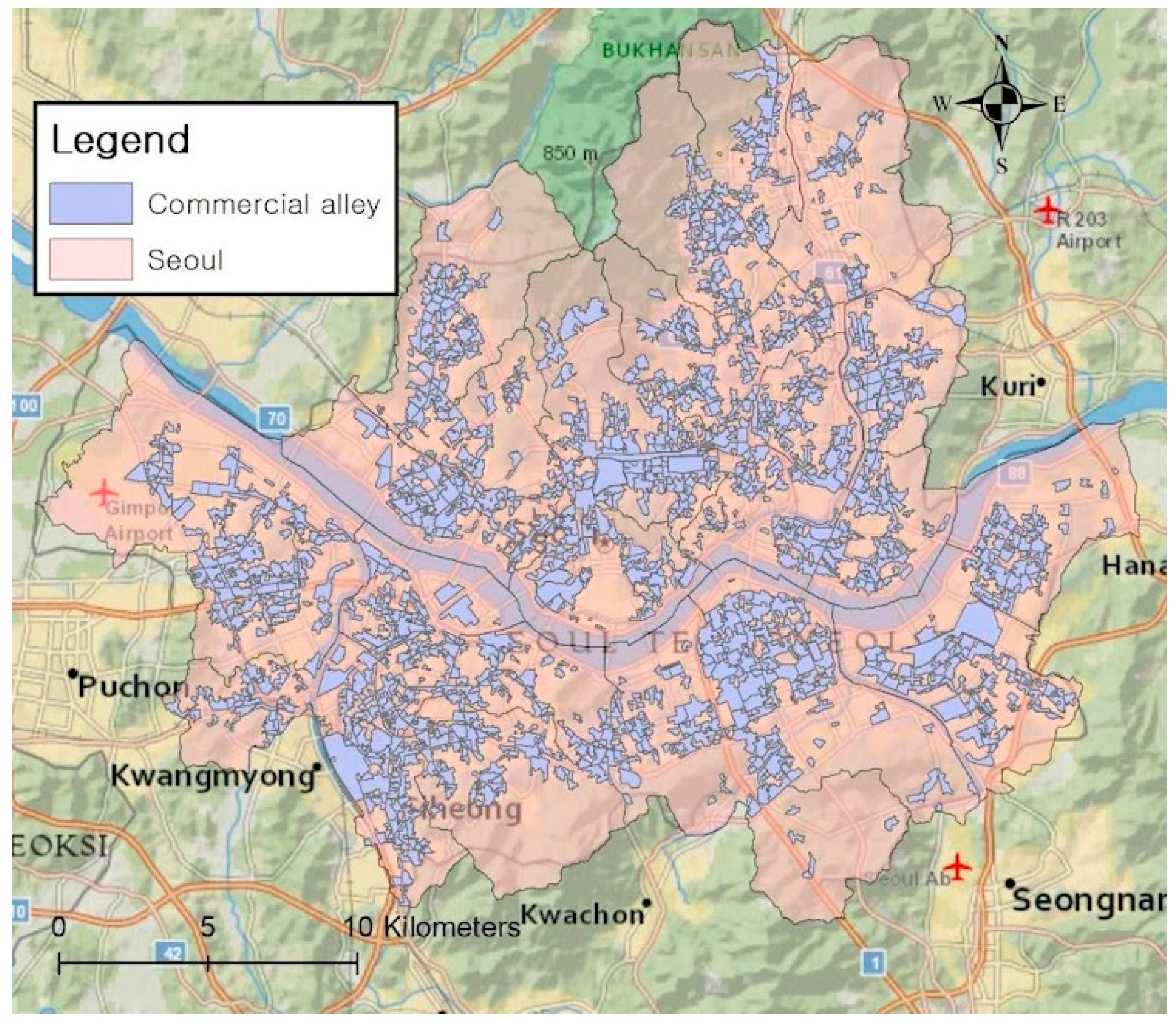
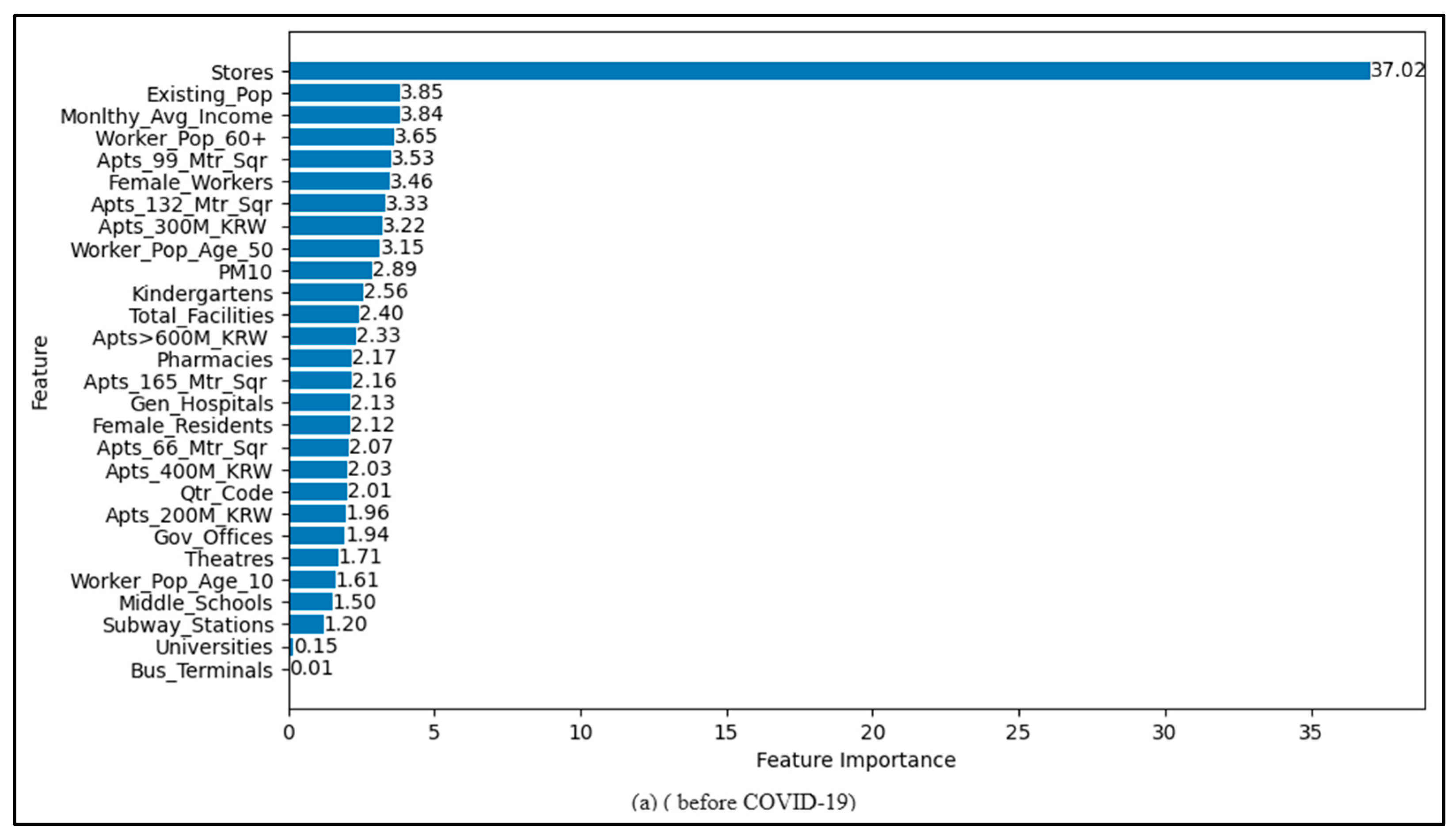
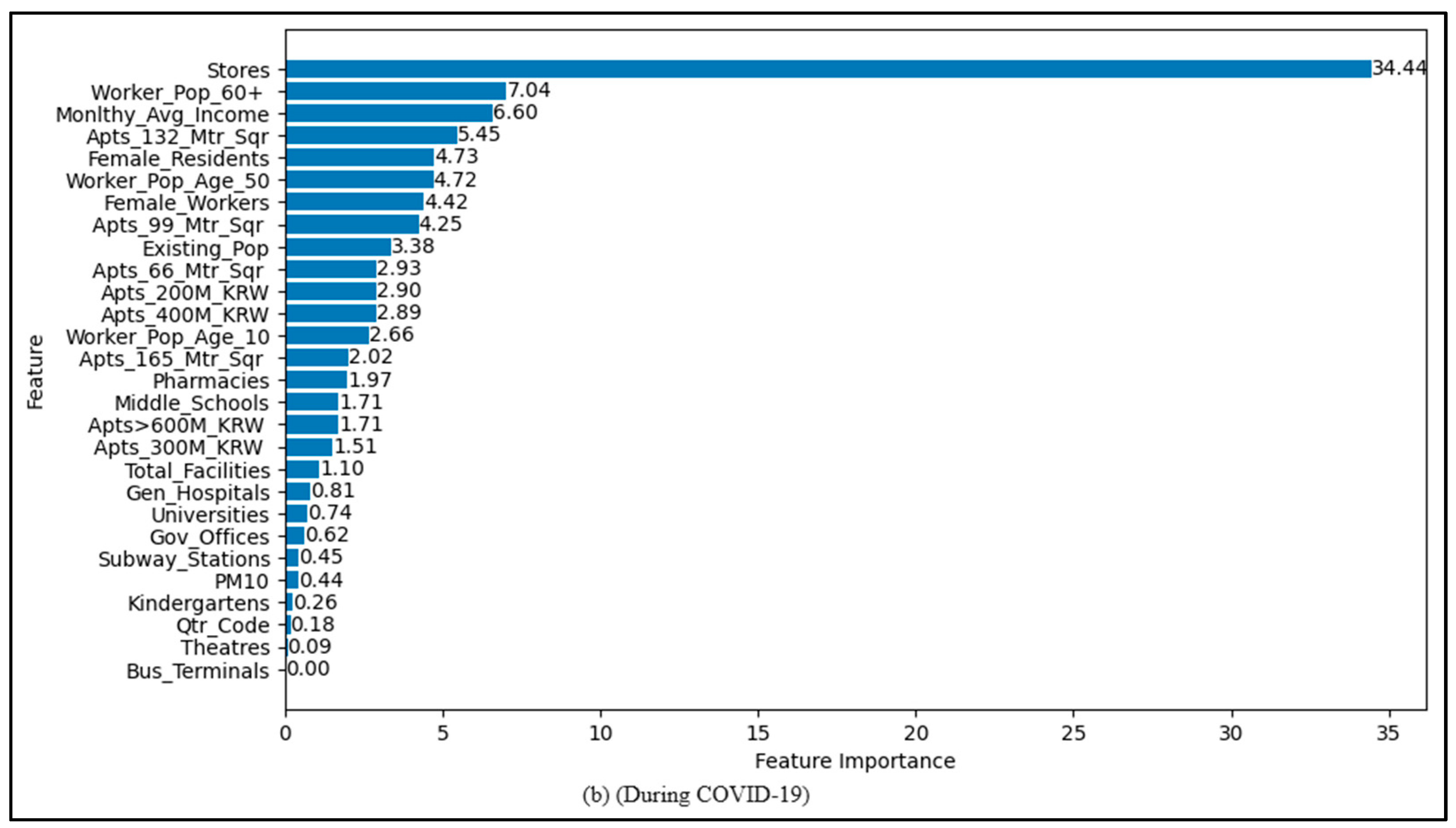
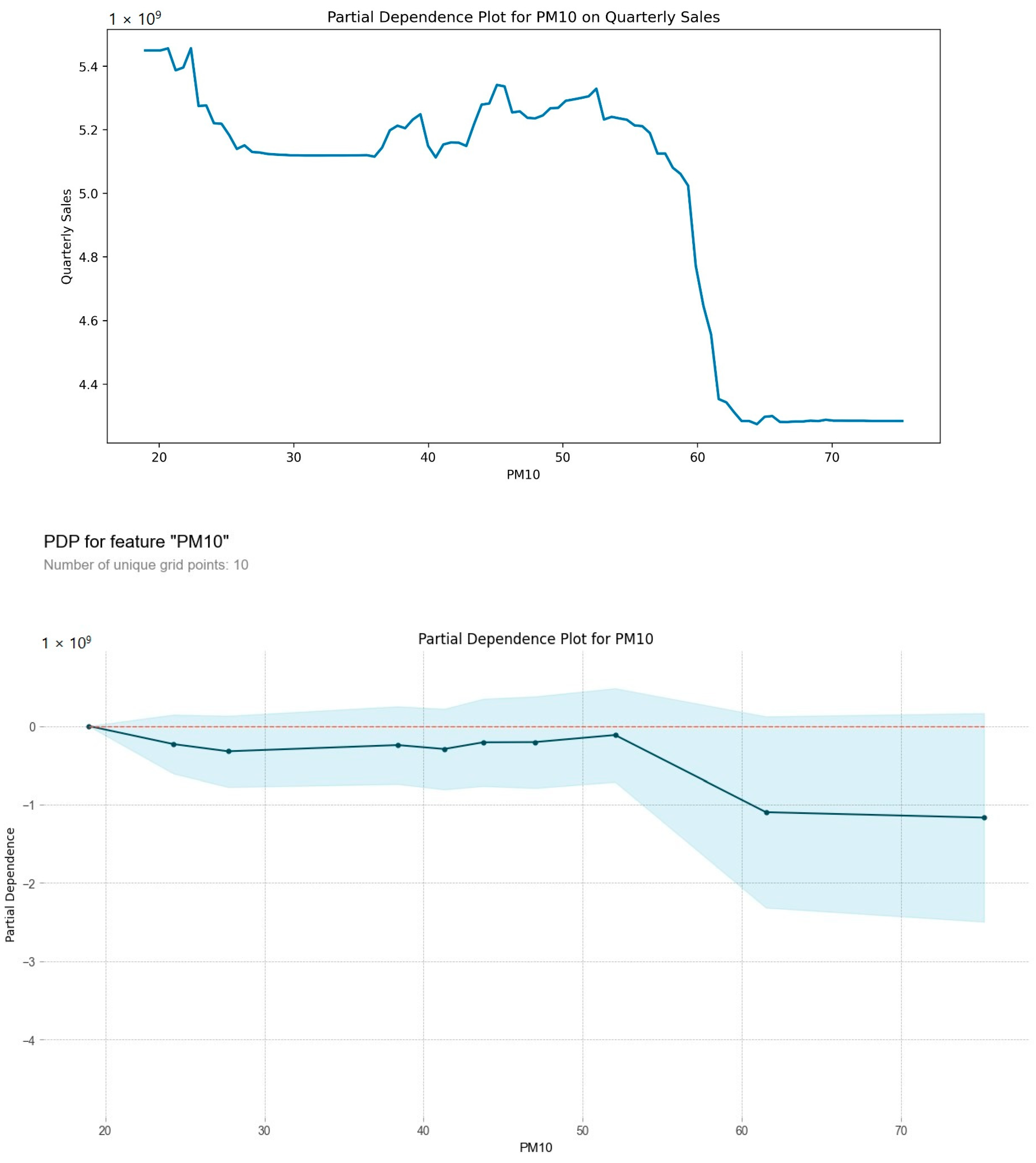


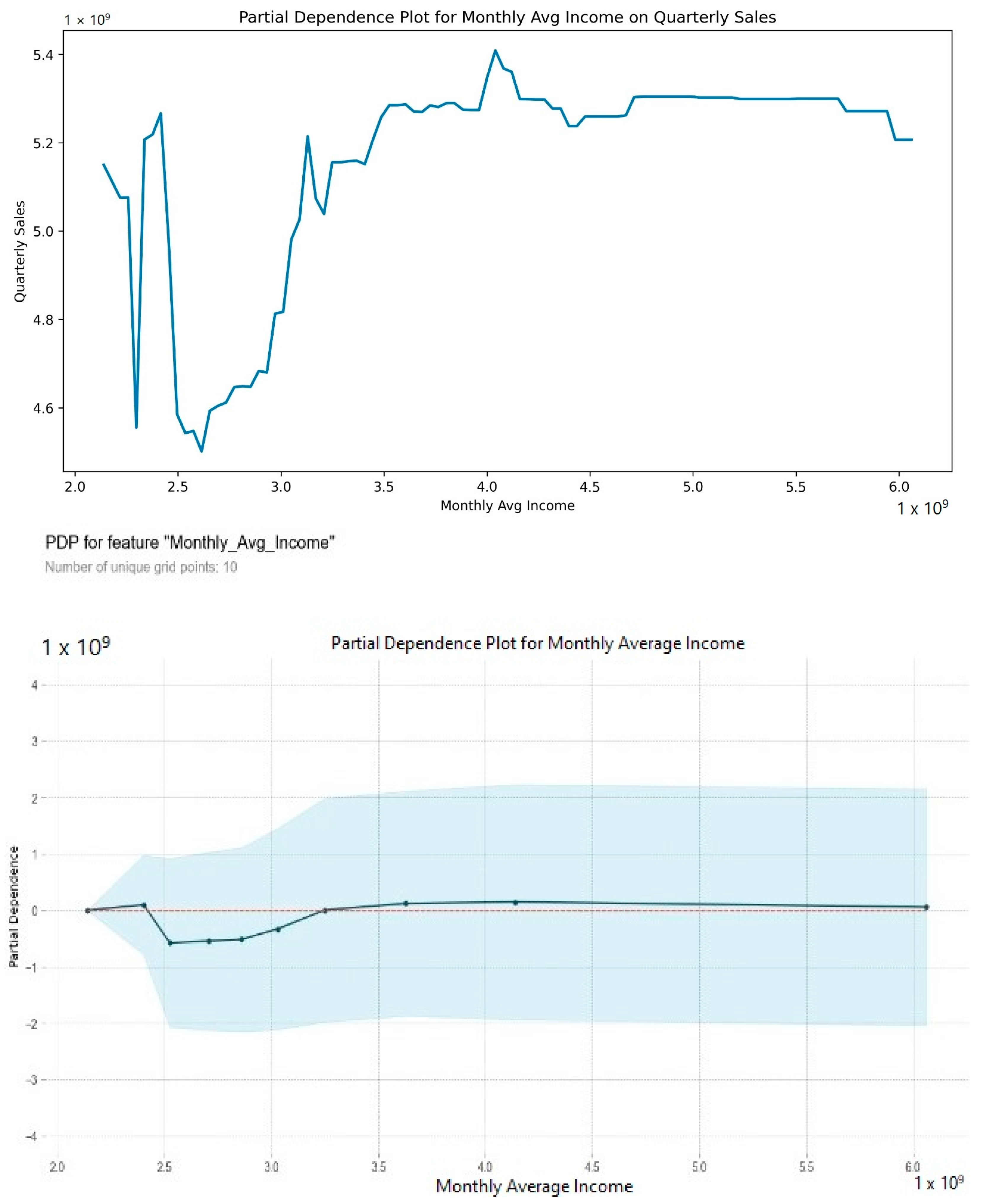

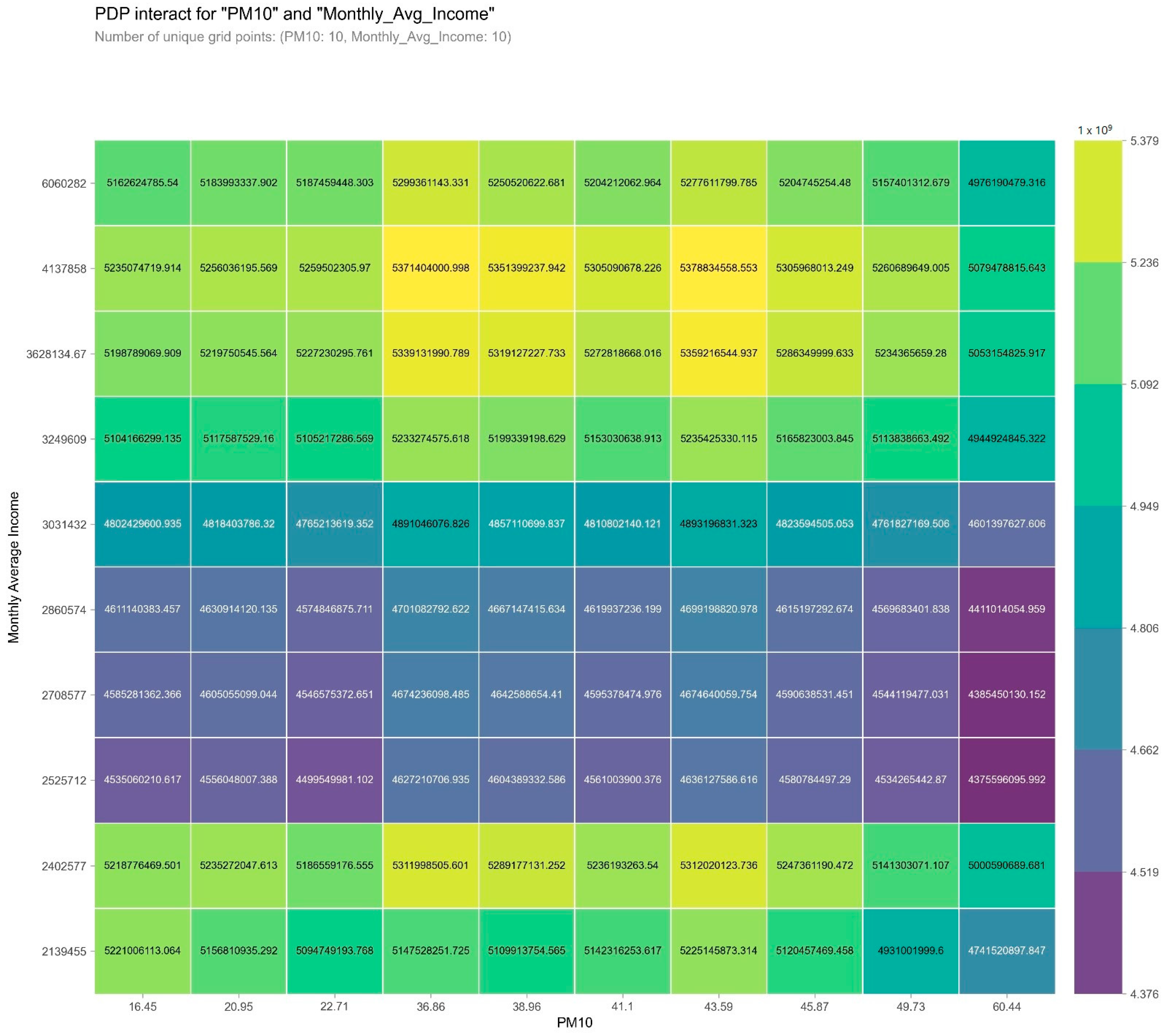
| Name | Description | Notes | |
|---|---|---|---|
| Target | Sales | Level of total sales of all businesses in each commercial alley | Seoul commercial alley data |
| Predictor | Stores | Number of all businesses in each commercial alley | Seoul commercial alley data |
| Household related to the area of the apartment | Number of households living in apartments under 66 or greater than 66, 99, 132, or 165 square meters | Seoul commercial alley data | |
| Household related to the price of the apartment | Number of households living in the apartment pricing under USD 100,000 or greater than USD 100,000, USD 200,000, USD 300,000, USD 400,000, USD 500,000, or USD 600,000 | Seoul commercial alley data | |
| Income (KRW) | Average monthly income | Seoul commercial alley data | |
| Facility | Number of facilities including total, public facilities, banks, hospitals, clinics, pharmacies, kindergarten, elementary schools, middle schools, high schools, colleges, department stores, supermarkets, theaters, accommodations, airports, railway stations, bus terminals, subway stations, and bus stops | Seoul commercial alley data | |
| Dynamic population | Total, male, female, 10s, 20s, 30s 40s, 50s, over 60s; Monday, Tuesday, Wednesday, Thursday, Friday, Saturday, and Sunday | Seoul commercial alley data | |
| Resident population | Total, male, female, 10s, 20s, 30s, 40s, 50s, and over 60s | Seoul commercial alley data | |
| Worker population | Total, male, female, 10s, 20s, 30s, 40s, 50s, and over 60s | Seoul commercial alley data | |
| Quarter | Quarter of a year | Seoul commercial alley data | |
| Air pollution | PM10 concentration | Air Korea |
| Hyperparameter ranges for tuning | RF | maximum depth [5, 10, 15, 20] minimum samples leaf [1, 2, 4] minimum samples split [2, 5, 10] number of estimators [100, 500, 1000, 1500, 2000] cost complexity pruning alpha [0.0, 0.01, 0.05, 0.1, 0.2] maximum features [‘sqrt’, ‘log2’, none] |
| XGB | gamma [0.5, 1, 5, 10] learning rate [0.01, 0.05, 0.1, 0.2] maximum depth [3, 4, 5, 6, 7] number of estimators [100, 500, 1000, 1500, 2000] subsample [0.8, 0.9, 1.0] subsample ratio of columns for each tree [0.6, 0.8, 1.0] L1 regularization [0.0, 0.01, 0.1, 0.5] L2 regularization [0.0, 0.01, 0.1, 0.5] | |
| Catboost | iterations [100, 500, 1000, 1500, 2000] depth [5, 10, 15] learning rate [0.01, 0.05, 0.1, 0.2] subsample [0.8, 0.9, 1.0] column sample by level [0.6, 0.8, 1.0] L2 regularization coefficient for leaf values [1, 3, 5, 10] | |
| LightGBM | number of estimators [100, 500, 1000, 1500, 2000] maximum depth [3, 4, 5, 6, 7] number of leaves [31, 63, 127] learning rate [0.01, 0.05, 0.1, 0.2] subsample [0.8, 0.9, 1.0] column sample by level [0.6, 0.8, 1.0] L1 regularization [0.0, 0.01, 0.1, 0.5] L2 regularization [0.0, 0.01, 0.1, 0.5] | |
| Optimized hyperparameter combination | RF | maximum depth = 20, minimum samples leaf = 2, minimum samples split = 2, number of estimators = 500, cost complexity pruning alpha = 0.0, maximum features = ‘log2’ |
| XGB | gamma = 10, learning rate = 0.05, maximum depth = 6, number of estimators = 1500, subsample = 0.9, subsample ratio of columns for each tree = 1.0, L1 regularization = 0.01, L2 regularization = 0.5 | |
| Catboost | iterations = 2000, depth = 10, learning rate = 0.2, subsample = 0.9, column sample by level = 0.6, L2 regularization coefficient for leaf values = 5 | |
| LightGBM | number of estimators = 1500, maximum depth = 6, number of leaves = 63, learning rate = 0.05, subsample = 0.9, column sample by level = 0.6, L1 regularization = 0.1, L2 regularization = 0.0 |
| RF | XGB | Catboost | LightGBM | |||||
|---|---|---|---|---|---|---|---|---|
| 2018–2019 | 2020–2021 | 2018–2019 | 2020–2021 | 2018–2019 | 2020–2021 | 2018–2019 | 2020–2021 | |
| R2 | 0.90 | 0.95 | 0.92 | 0.96 | 0.92 | 0.96 | 0.92 | 0.96 |
| MSE | 2.39 | 1.65 | 1.86 | 1.07 | 1.82 | 1.15 | 1.84 | 1.16 |
Disclaimer/Publisher’s Note: The statements, opinions and data contained in all publications are solely those of the individual author(s) and contributor(s) and not of MDPI and/or the editor(s). MDPI and/or the editor(s) disclaim responsibility for any injury to people or property resulting from any ideas, methods, instructions or products referred to in the content. |
© 2024 by the authors. Licensee MDPI, Basel, Switzerland. This article is an open access article distributed under the terms and conditions of the Creative Commons Attribution (CC BY) license (https://creativecommons.org/licenses/by/4.0/).
Share and Cite
Ashraf, K.; Lee, K.; Kim, G.; Kang, J.-Y. Sales in Commercial Alleys and Their Association with Air Pollution: Case Study in South Korea. Sustainability 2024, 16, 530. https://doi.org/10.3390/su16020530
Ashraf K, Lee K, Kim G, Kang J-Y. Sales in Commercial Alleys and Their Association with Air Pollution: Case Study in South Korea. Sustainability. 2024; 16(2):530. https://doi.org/10.3390/su16020530
Chicago/Turabian StyleAshraf, Khadija, Kangjae Lee, Geunhan Kim, and Jeon-Young Kang. 2024. "Sales in Commercial Alleys and Their Association with Air Pollution: Case Study in South Korea" Sustainability 16, no. 2: 530. https://doi.org/10.3390/su16020530
APA StyleAshraf, K., Lee, K., Kim, G., & Kang, J.-Y. (2024). Sales in Commercial Alleys and Their Association with Air Pollution: Case Study in South Korea. Sustainability, 16(2), 530. https://doi.org/10.3390/su16020530








